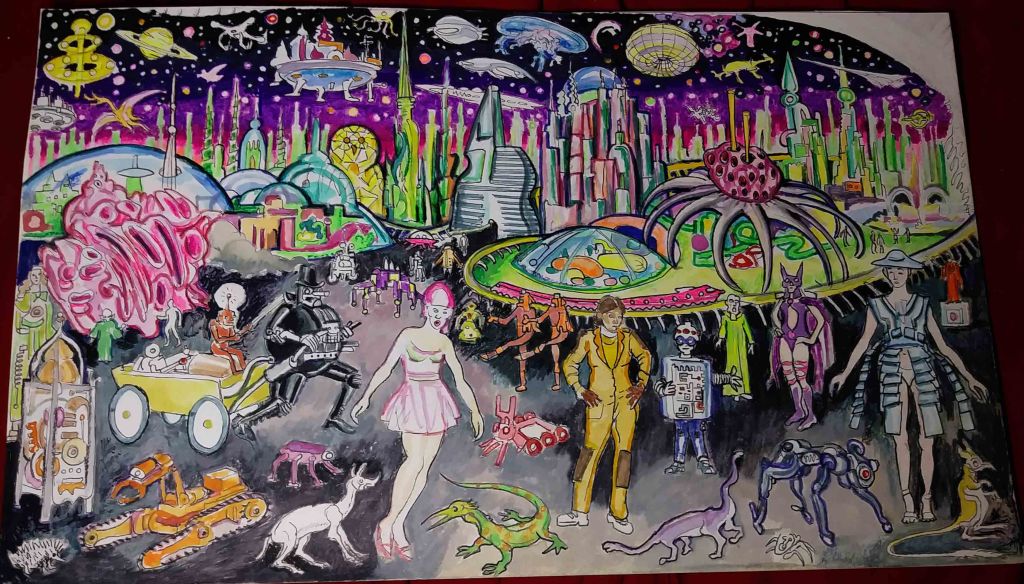You are currently browsing the category archive for the ‘Gothic’ category.

Happy Halloween! As a special inktober treat for the special day, here is another little allegorical ink drawing of our times featuring strange orchid bishops sheltering in their Romanesque monasteries. The churchmen (who do not seem especially holy or worthwhile) interact with their doomed milieu through their little handheld personal communication devices. Meanwhile the haunted world outside is subject to dragon attack, volcanic eruption, war, and doom.
As ever, the strip of nature in the foreground is the true key to the meaning of the composition.

Our Inktober special feature of Halloween-adjacent pen-and-ink drawings continues with this enigmatic golden orchid monastery piece which I drew with colored inks on yellow paper.
Lately I have been drawing a series of intricate altarpiece-style compositions after the style of Medieval illuminators (whose seminal contributions to art, culture, and media have been underappreciated because of the post-Vasari cult of celebrity). Hopefully writing about these illustrations in these posts will help contextualize the themes I am trying to highlight.
Here is a little monastic microcosm of the world. In one monastery, a white-haired abbot lords it over his little flower novices. In a sister monastery, the mother superior and her votaries carefully send out an intimate message to the monks by means of technology. Sundry lizard people, extinct animals, and cloaked figures roam about in the space between the two houses as a rain of yellow orchid blossoms falls down from the heavens.
To my mind, the most important part of this composition is the tiny strip of nature in the foreground–a little ecosystem of weeds, wildflowers, seeds, nemotodes, myriapods, and maggots (who are furiously breaking down a mouse skull). The human world of sly courtships, status posturing, and religious grandstanding grows up out of this substrate and pretends to be superior to it (while actually being entirely dependent on the microscopic cycles of life). All of the pompous & made-up things which humankind uses to dress up our savage primate drives do not change the fact that ecosystems are of paramount importance.
The religions of Abraham (among others) put animals and the natural world at the bottom of their moral hierarchy. I believe they are ultimately doomed because of this stupid outlook. Whether they will take us all to a garbage-strewn grave with them remains an open question.
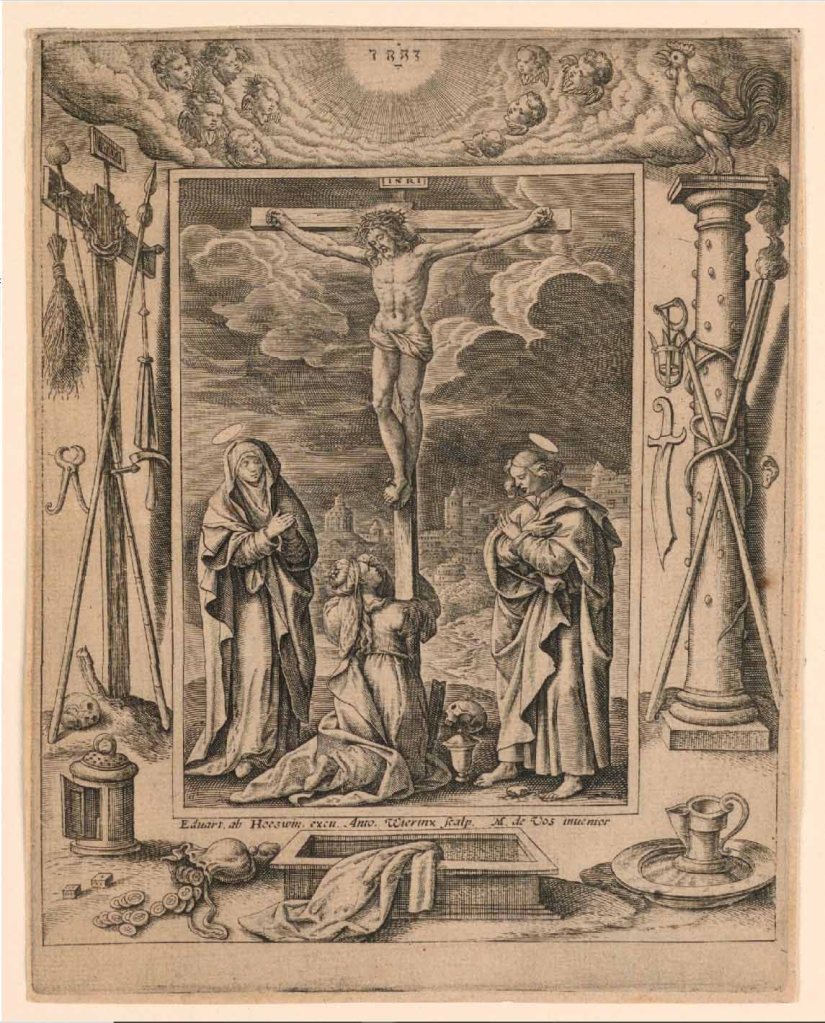
It is Good Friday, and as per tradition, here is an exquisite crucifixion artwork to mark the occasion. The beautifully engraved print is remarkable for its enormous quality, precision, and detail: just look at the lightning striking Jerusalem in the distant background! However it is also remarkable for the two (or three) levels of reality which the artists/printmakers have divided it into. In the central rectangle, Jesus is crucified on a hill in Israel as Mary, Mary Magdalen, and Saint John lament. Moving outwards by a degree, we find a second, rather more metaphorical frame which presents the instruments of the passion: the cross, the scourge, the nails, the pitcher of vinegar. Only as we examine the carefully engraved items in depth do we discover how allegorical these images really are. The coins are avarice. The flail is cruelty. The cock is denial. The vinegar is bitterness. The sepulcher is fear. These bedrock emotional drives are the true tools of the Passion. It is by means of the universal nature of humankind that Jesus was slain, but only by transcending such things and moving inwards to a more divine and transcendent level of faith, tenderness, and compassion can we be redeemed.
Of course there is an unspoken third level as well–of bare paper which has not been pressed by the plate. This reminds us that we are looking at a little nesting universe of profound ideas which are the contrivance of gifted artists working in the real world with ink, burins, presses, and paper in order to make us think more carefully about existence…or such would be the case if you were looking at this in a Duke’s library or the Cooper Hewitt Museum. Instead you are looking at this on the internet on glowing pixels on my blog–so there is really a fourth meta-level of ideological interpretation (conveniently provided by me, some random guy on the internet just writing stuff). The 16th century was an age when thrilling new media lead humankind to terrible excesses (there is a reason all of those torture implements look so realistic). Theologians, political leaders, and rabble-rousers used these new tools to whip up the sectarian passions of Christ’s followers and drive the faithful to slay the faithful in vast religious wars. There is a symbolic reason the scimitar, the torturer’s tongs, and the open crypt are closer to the viewer than Christ is: God is separated from us not just by space and time, but by supernatural and moral hierarchy as well (and by ethnicity too, as the Hebrew at the top reminds us). I wonder if His followers in the modern era will see what the Christian artists of the new mass media arts of the 16th century were trying so hard to explain…
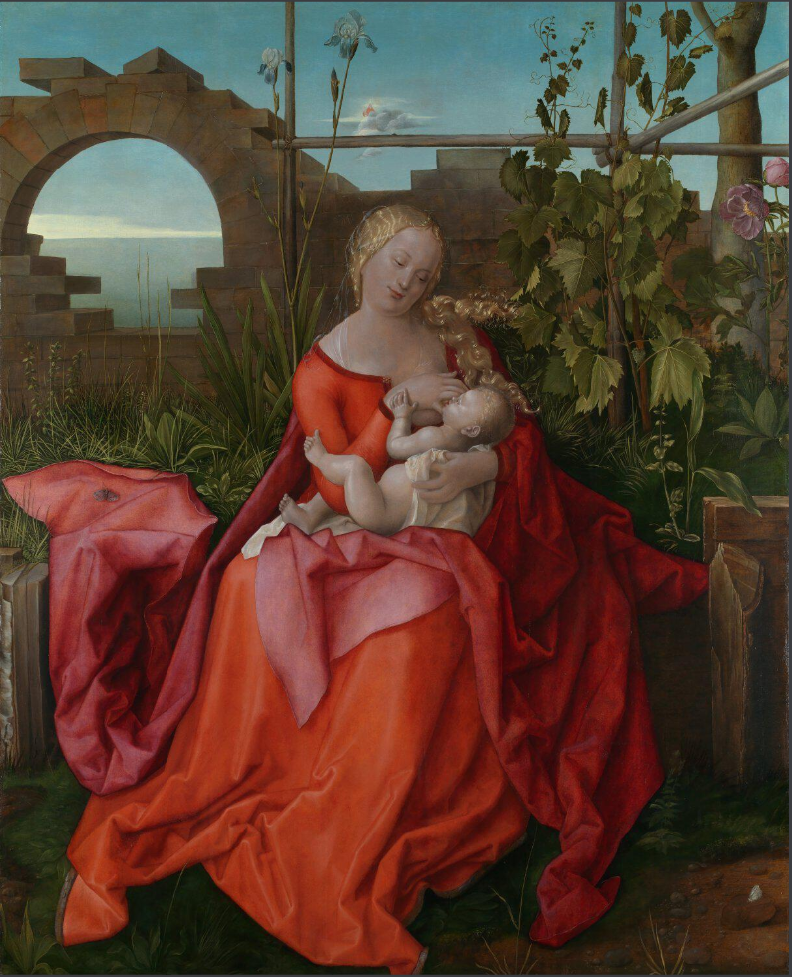
Today is world pigment day(!), and I would like to celebrate by showcasing kermes red, one of my favorite pigments (sometimes also known as carmine in English). Not only is it a gorgeous shade of deep crimson pink, but explaining its name and the way it was manufactured provides a sort of educational primer on pigments. Also, since this pigment dates back to antiquity, it features in some amazing historical works–particularly as women’s lips, make-up, and dresses. Additionally, the pigment is made from living creatures, so there is a certain horror aspect to it. The only sad aspect to all of this is that I have never used real kermes pigment to paint: it is too expensive and I have always settled on synthetic substitutes.
I am saying “kermes red”, but the pigment’s true name is “kermes lake red”. A lake pigment is distinct from a pigment made from ground minerals (like say vermilion) because the dye is precipitated with a “mordant” (a chemical which acts as a binder). Another way of saying this is that lake pigments tend to be organic and are often quite fugitive as well. Kermes are actually nasty little scale insects which parasitically suck the roots of oak trees. The brightest reds are obtained by collecting the female insects with eggs still inside their bodies. Then they are dried, crushed, and bound with mordants! Kermes based inks and paints are beautifully translucent and were perfect for delicate washes. By building up multiple layers or by painting in Kermes atop vermilion, one could obtain gorgeous luminous effects. For example, in this tiny masterpiece by Perugino, note how newly resurrected Jesus is wearing a pink robe–more properly a kermes lake himation, whereas the lesser musicians, mercenaries, and mourners have vermilion pants and hats (well, not that guy in the front right corner, but you understand what I mean). This tiny picture is one of my favorite works in the whole Metropolitan museum, by the way (when they bother to show it).

Kermes dyes were used in Old Testament times when it was used to produce the scarlet yarn in the curtain of the temple of Solomon as well as various other holy vestments (I probably ought to write a post about this alone to go with the sacred lost blue of Israel post). The method of using these dyes was lost for a time, but seemingly revived in the middle ages when scarlet became the super-expensive pigment of the high aristocracy (and of church cardinals, of course). It was replaced by cochineal from the new world–a similar but even more vivid scale insect (which, for a time, was the second most valuable commodity from the Spanish colonies, after silver). Kermes now is a niche pigment and it has been superseded by all sorts of chemically refined dyes (particularly the quinacridone dyes).

Happy Saint Patrick’s Day! Every year, Ferrebeekeeper dedicates today’s blog post to the myths and legends of the fair green island. This tradition started back in 2011 with a post about Ireland’s unofficial mascots, the leprechauns (those little magical men did some heavy lifting in popularizing this blog and they are still the second or third most popular post of all time). Subsequent years featured the sad tale of Oisín and Niamh, a description of the dark sky spirits which haunt the night sky, the tale of Daghda’s harp (which is there on the old flag), the myth of the leannán sídhe (a vampire woman who represents life as an artist), and the story of the salmon of wisdom (a metaphorical fish of universal knowledge). These tales are wonderful (and horrible too) but they are all from Ireland’s pre-Christian past, so for this SAINT Patrick’s Day, let’s head to the Christian myths of Ireland.
Now the hagiography of Saint Patrick himself has always struck me as a bit dull (plus, old Patrick was really from England anyway!) however his contemporary, Saint Ciarán of Saigir was a churchman much more in the florid style of ancient Irish myth–and a noted animal lover rather than a persecutor of serpents. Although the details of the lives of (possibly mythological) magical bishops from the dark ages are a bit uncertain, it seems that Ciarán was born in the 5th century as a noble in Osraigh (that link is pretty interesting but also so painfully Irish that I felt like I was drinking Harp beer and listening to a lilting ancient in some stone tavern when I read it). Ciarán’s first miracle occurred when he was a child. A predatory kite swooped down and killed a little songbird sitting on a nest in front of the boy. Ciarán admonished the kite for its cruelty and then breathed life back into the little bird.
Realizing that the compassionate new faith was for him, Ciarán went abroad to learn the ways of the church. After studying Christianity at Tours and then at Rome, young Ciarán returned to Ireland in the 6th century and built a stone hermit’s cell in the woods of Upper Ossory. His first converts were forest creatures who took up the monastic habit upon hearing Ciarán’s sermons, so parts of his hagiography read like Redwall with Brother Badger, um, badgering Lay Brother Fox about the latter’s habit of stealing footwear. His miracles are a bit peculiar as well, and include transforming the water of a well into a potent intoxicant with the taste of honey and performing a magical abortion on a raped nun named Bruinnech (reading between the lines here, this seems like a story of preventing honor killings and stopping an ever-escalating cycle of vengeance before it started, but it is still a strange look for one of “the twelve apostles of Ireland”).
There are other tales of Ciarán’s life which I am leaving out (just as I am leaving out the various monasteries and churches he founded and his episcopal acts), however I will share the story of his death. Ciaran was not beheaded by pagans or crushed by Romans or anything like that–he died from old age surrounded by adoring monks, students, and parishioners (and probably hedgehogs, rabbits, and turtles wearing robes).
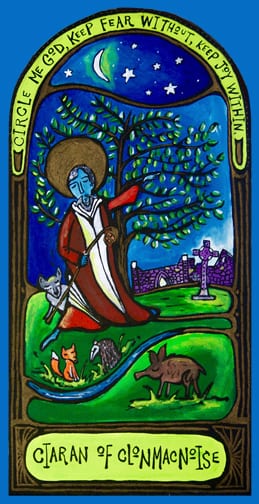
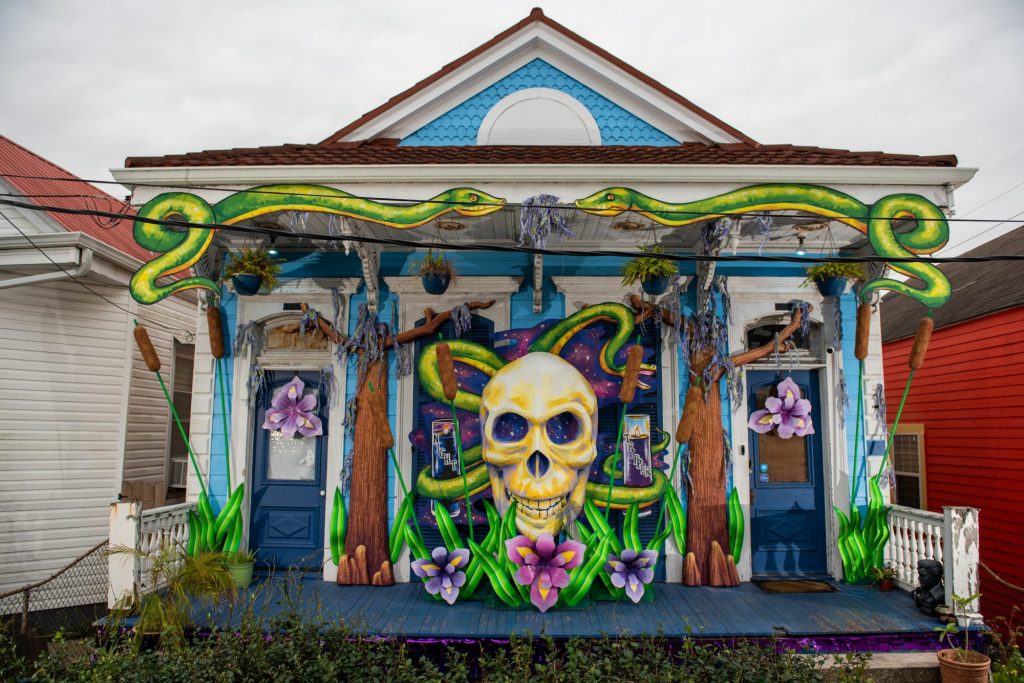
Happy Mardi Gras! Tonight at midnight, the Lenten season of austerity begins. Today is therefor a holiday of merriment and excess in Catholic parts of the world. The most famous Mardi Gras celebration in the United States is, of course, the great Mardi Gras parade in New Orleans, finally returned to full glory this year after two long years of plague and quarantine. During the corona years, however, New Orleans natives (and members of the illustrious parade krewes which put the spectacle together) did not entirely give up! They decorated certain key houses around the Big Easy in the same manner as parade floats. For tonight’s carnival delectation, here is a little gallery of some of those lovely cottages wearing their mad finery:

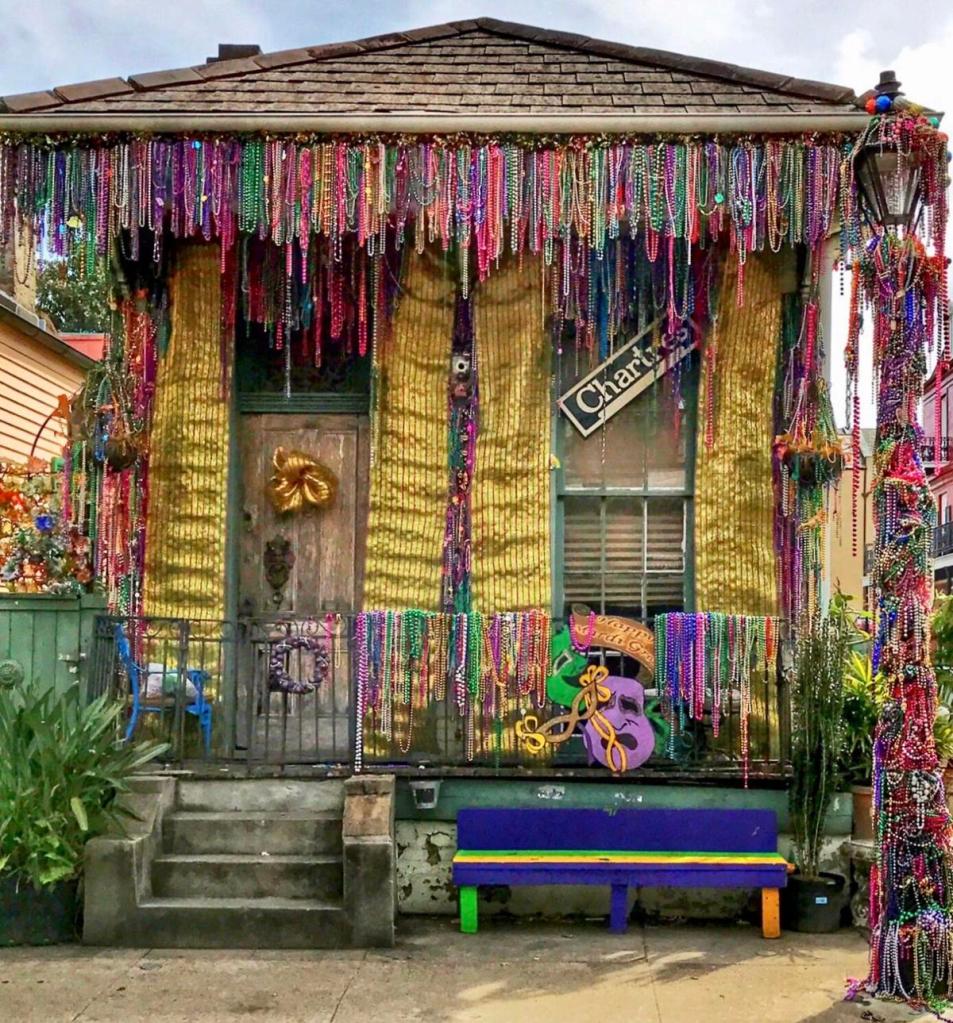

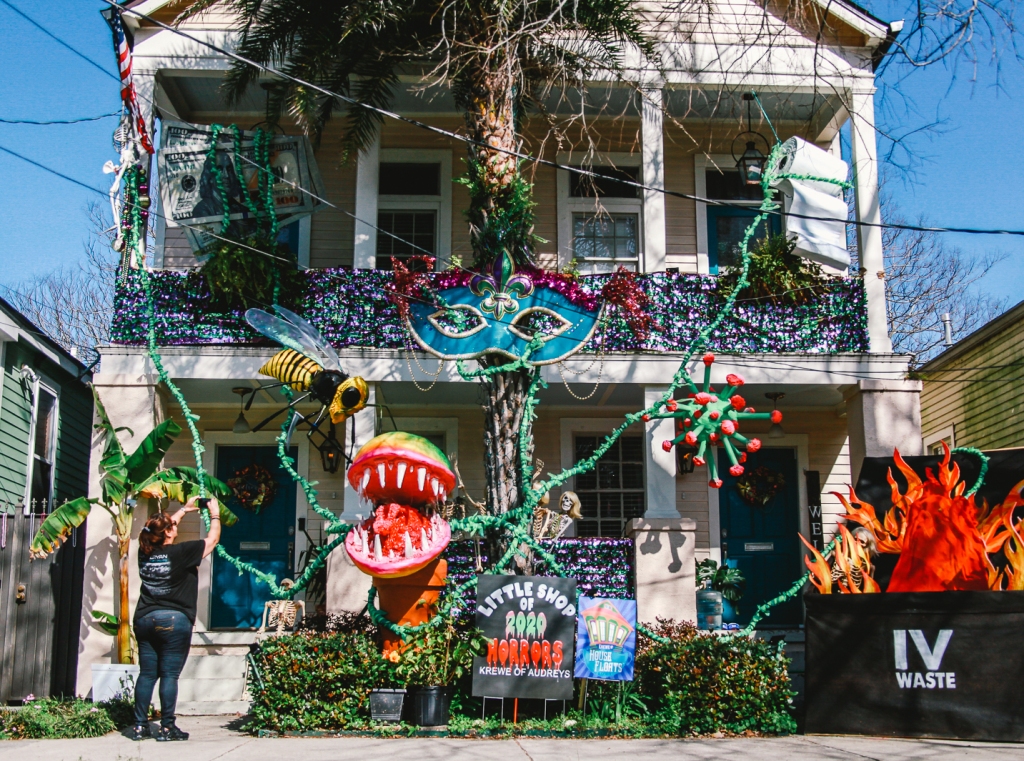
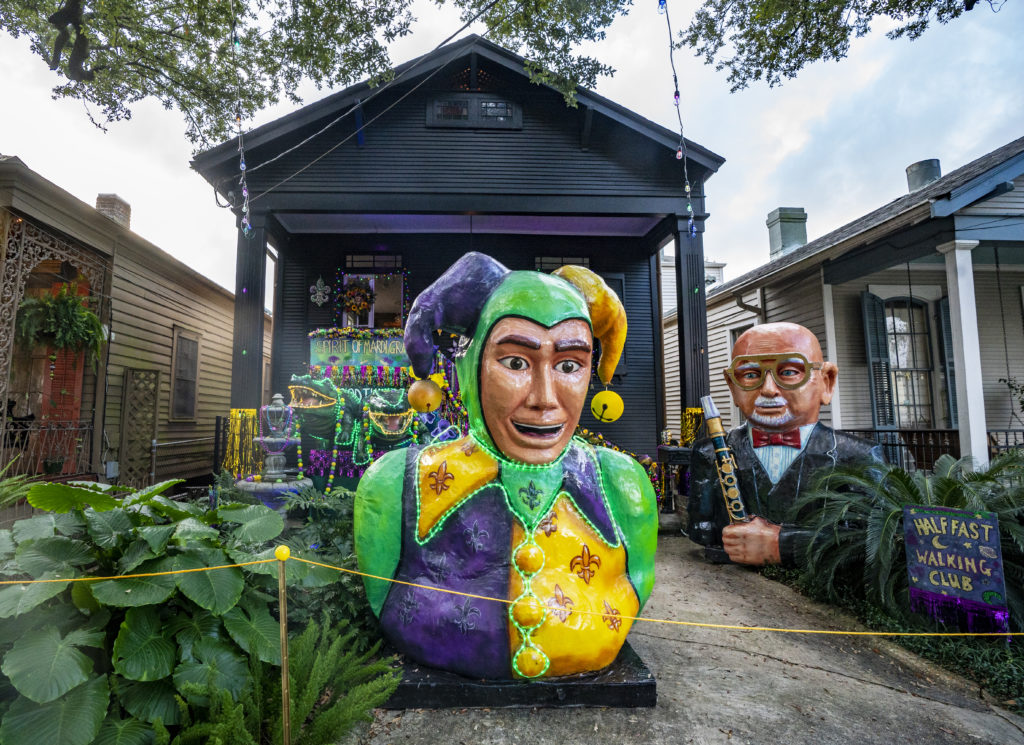




Laissez les bons temps rouler!
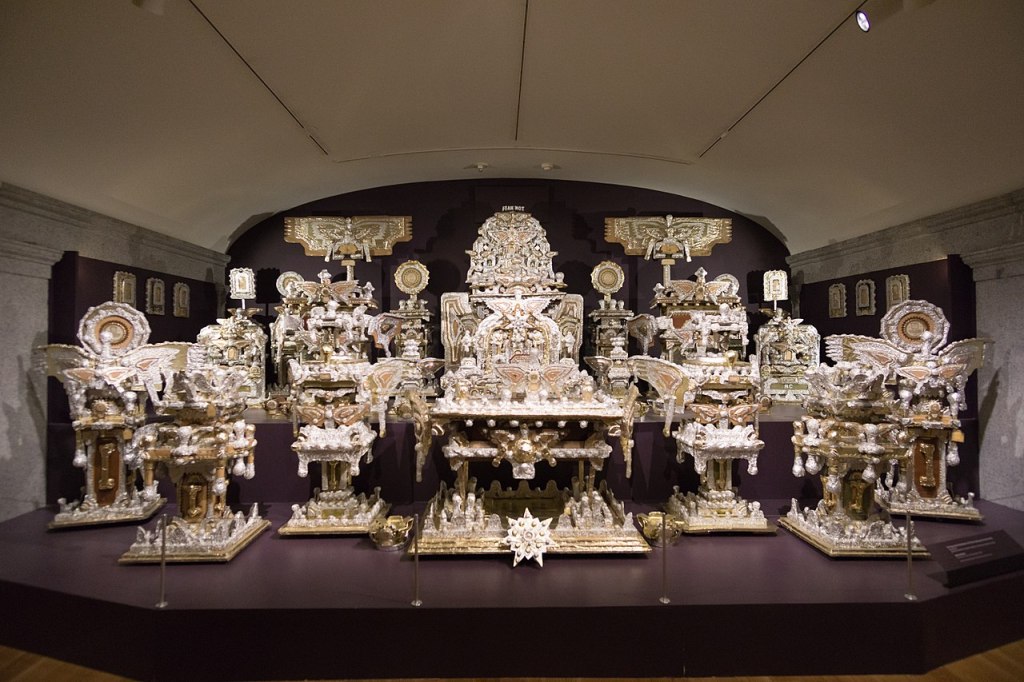
Usually Ferrebeekeeper writes about crowns, but today, as a special treat to celebrate the end of February (which is also Black History month), we are going to write about a throne instead…and this is not just any throne! It is also my favorite visionary art installation [as an aside, I believe it would help to contextualize the problematic nature of monarchy if we called all thrones “visionary art installations”–and it wouldn’t even really be inaccurate]. Anyway, above is the Throne of the Third Heaven of the Nations’ Millennium General Assembly, by American outsider artist James Hampton which is currently held at the Smithsonian Museum of American Art in Washington DC. Created between 1950 and 1964, the enormous work consists of 180 individual objects hand-crafted out of broken furniture and everyday found objects which were gilded with aluminum and gold foil.
Hampton’s tale is as American as possible, while somehow simultaneously as outsider as possible too. He was born in South Carolina in 1909, the son of a Baptist preacher with the same name. His father, James Hampton Senior was a traveling Baptist preacher and a gospel singer, but he was also a grifter and a ex-convict with a history of time in the chain gang. He abandoned his family and vanished away into the William Faulkner style goings-on of the south during the tumultuous decades of the teens, twenties, and thirties leaving his 4 children and wife to scrape by as well as possible.

After this hard-scrabble upbringing, young James Hampton moved to Washington D.C. where he was a short-order cook during the Depression and was then drafted into The United States Army Air Force during Word War II. He served repairing airstrips in Guam for which he received a Bronze Star. In Guam he also first began building visionary devotional shrines. After the war he moved back to Washington and obtained a job as a janitor at the General Service Administration, where he worked until his death of stomach cancer in 1964. We would probably not remember him at all, except, when he died, his landlord approached his sister about what to do with the contents of the garage which Hampton used as a workspace/devotional area. Hampton had largely kept his artwork hidden from even his tiny circle of friends and family (perhaps he did not even regard it as artwork per se). Only after his death did it come to the world’s attention, along with St James: The Book of the 7 Dispensation a religious book which he mostly wrote in a private (and untranslated) tongue.
Hampton’s Christianity was non-sectarian (enough of his writing is in English to inform us that he wisely believed that the doctrinal schisms which characterize organized Christianity detract from the sacred unity of God) and highly mystical. I first saw the throne on a High School Field Trip in the nineties, when its awesome otherworldly glory and strangeness was enough to silence a whole class of 16 year olds (an achievement accomplished by few other cultural masterpieces in the nation’s capital). Its glistening cat-eyes and complex Baroque shapes are characteristic of American dime stores and carnivals of the early 20th century…and yet they also very much of Africa, Polynesia, and the Holy Land as well.
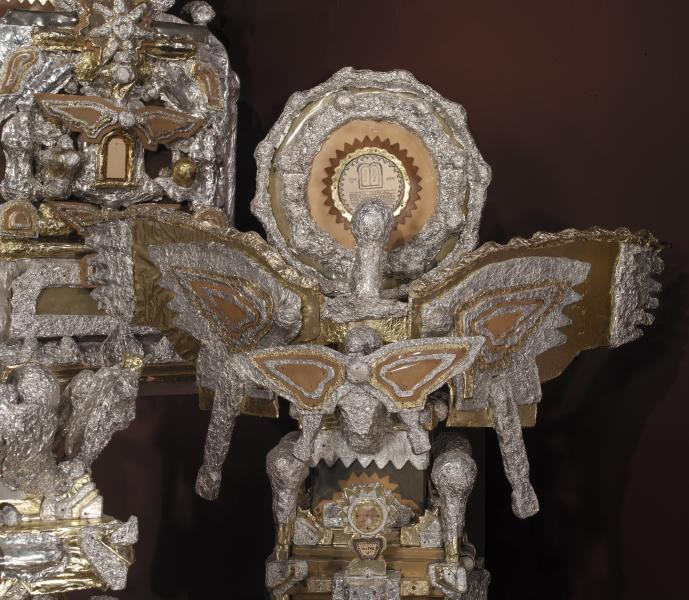
You will have to examine the shrine of your own–as with some of the finest religious art of South East Asia or the Middle Ages, its splendor and complexity initially baffle the eye. However, it is based on Saint John’s New Testament description of the silver and gold throne of God on Judgement Day (Revelations 4). This description includes mention of Christian elders wearing sacred crowns, and these crowns are very much a part of the larger installation, so even if you are lost in the material complexities of James Hampton’s personal devotion, at least there is highly recognizable iconography for the rulers of Earth…and for this blog’s readers too!
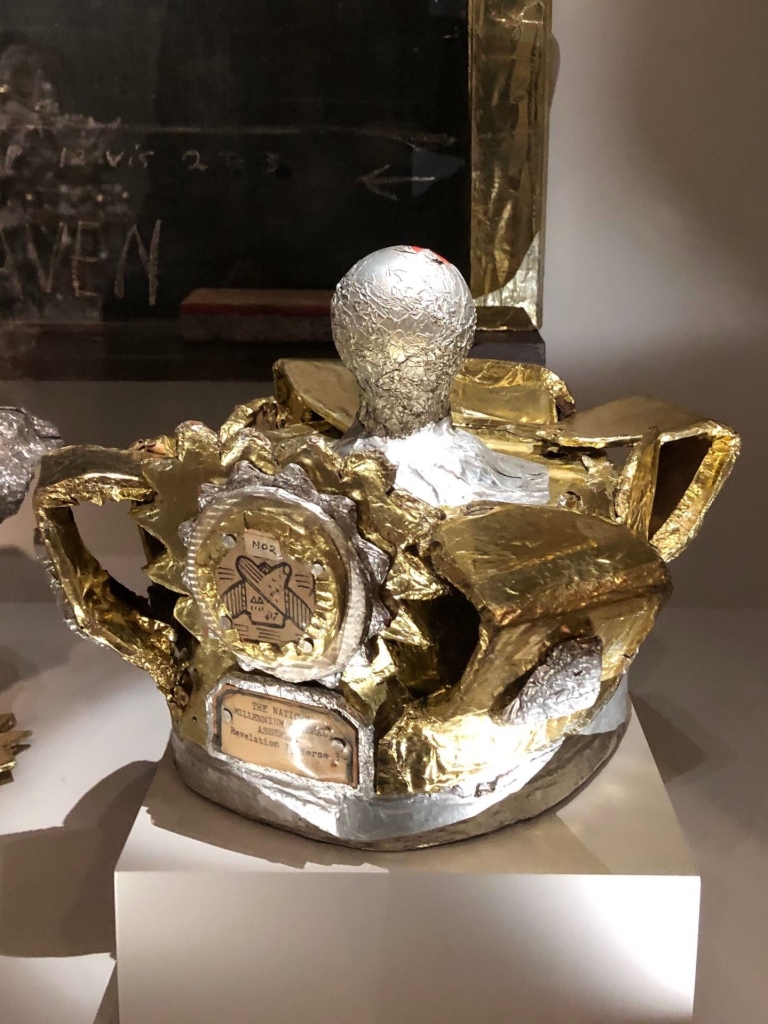

Happy Saint Valentine’s Day! To my shame I realize that last week I got all caught up in the breathtaking (ly amoral) spectacle of international sport and I failed to put up any new content during these winter doldrums. Therefore, here is my latest ink drawing which features a magnificent European wisent carefully weighing the moral arguments behind various species of monotheism (represented, respectively, by a cardinal from the developing world, a dodgy Mithraic priest in a tree, and a little person blowing a shofar). Although these characters could conceivably offer the noble zubr spiritual solace of one sort or another, my personal opinion is that the wood bison is likely to be most drawn towards some sort of personal animism as championed by the sentient tree, the condor, or the omnipresent flatfish. Kindly note the nightjar hiding by the oil lantern in the left foreground!

Ever since the beginning of the pandemic, I have been working on drawing with ink using a steel nib. Of all the drawing media I have used, pen and ink provides the most expressive and beautiful lines–provided you can avoid blotting, smearing, or spilling the ink. Alas, it is exceedingly easy to destroy your drawings (and your wardrobe) through the least mishap with the INDELIBLE ink. In the spirit of the masters of medieval illumination (who also utilized pen and ink), I have been drawing a series of strange floral monastic people–well, perhaps it is a bit unclear if they are people or paphiopedilums. In the picture above, a loving deity of growth irrigates the sentient crops as a kindly sister looks on. Beneath the grass, a caecilian hunts for destructive grubs among the roots and mycelia. Speaking of mycelia, kindly note the little gnome collecting mushrooms. In the heavens, a pelican flies by with a fish struggling in its beak while a bat-winged putto plays religious music on a lyre. The odd-man out in the composition is the friendly ring-tailed lemur who seems perplexed by this harmonious tableau (surely this can’t be Madagascar), but takes in in stride with sanguine primate good cheer.
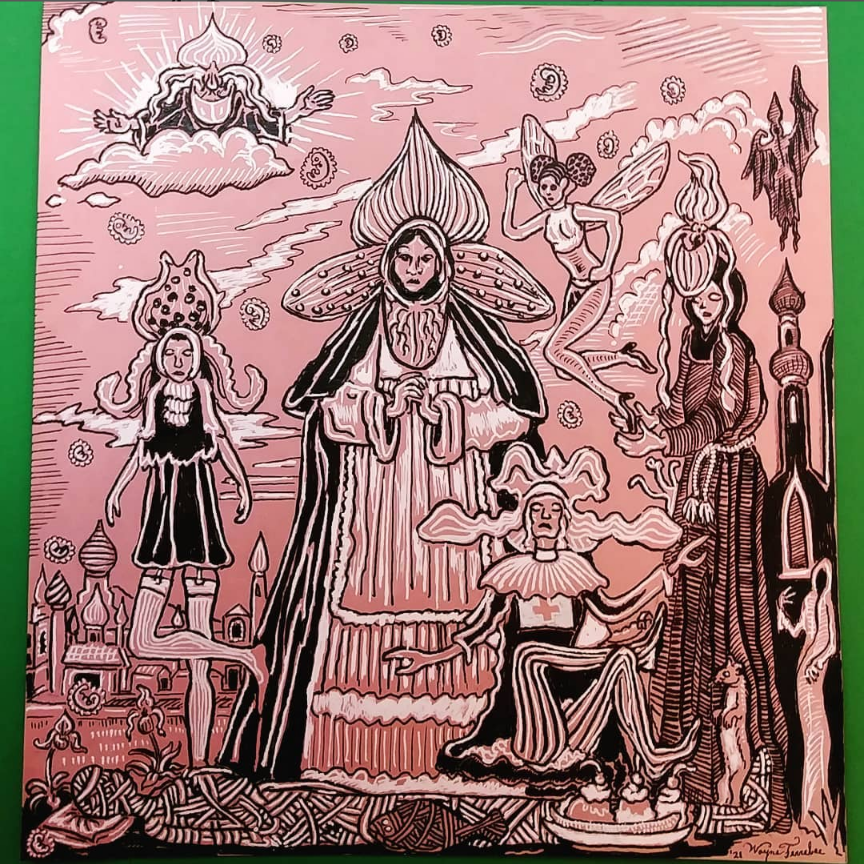
This second drawing is more complicated and harder to parse out. A little chapter of nuns have left their onion-domed convent to luxuriate in the heavenly effulgence. I feel like that aerobic-looking fairy may well be a lay-sister. Unfortunately, their repose is disturbed by a big, stiff, skinny mummy which is just lyin’ around on the lawn. Who on earth left it there and why? Also, why does the mummy have a mummified flatfish? The day is additionally marred by the presence two faceless apparitions to the extreme right. Drifting through the air everywhere are little zygote-spores of some sort (or are they little seeds of the flower people). It is good to see that life finds a way, even if the sisters are putatively uninterested in reproduction. Also there is an ermine (the very symbol of purity and moderation in Christian art) who is looking quite closely at a banana split.
I am pleased at the way that using black ink and white ink gives these peculiar allegories a feeling of dimensional form. Speaking of which, drawing with sumi ink this way also gives a literal 3 dimensional aspect to the work (albeit a slight one). If you run your fingers over these drawings, all of the lines are palpable and i had to photograph them multiple times because of little shadows and strange reflections cast by the raised ink.

